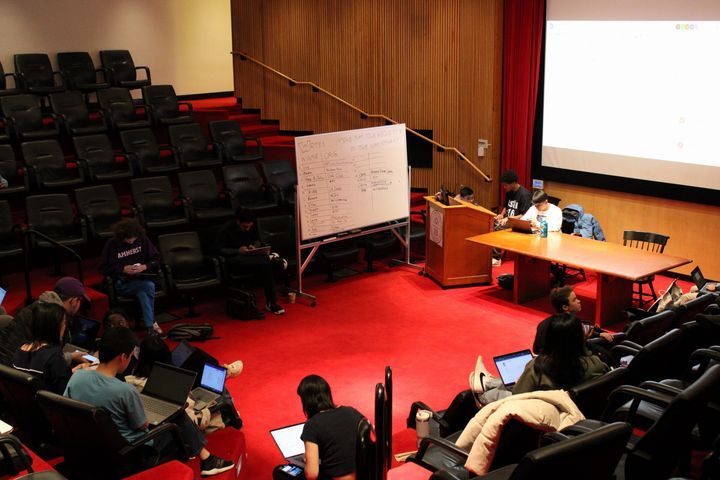AAS Budget Crunch Worries Club Sports Leaders
A smaller-than-normal budget has forced the AAS to scale back discretionary spending, leading some club sports teams to look elsewhere for funds.

Members of the crew team and ski and snowboard club, which have some of the largest budgets among student clubs, expressed disappointment and worry in the aftermath of a recent Association of Amherst Students (AAS) meeting that could not guarantee a full semester of funding for their respective clubs. The ongoing struggle to find sustainable funding has left the leaders of these clubs scrambling for answers.
Large club sports, such as the crew and ski and snowboard teams, generally receive a large chunk of their funding from the AAS’s club budget. However, even in a typical year, the club budget often does not cover all expenses that arise throughout the semester, leading clubs to apply for discretionary funding.
This spring, funding issues have been compounded by the annual spring concert and additional unforeseen budget constraints, meaning the AAS has around $100,000 less to fund student activities than in the fall semester.
As a result, at its meeting to determine club budgets, the AAS’ Budgetary Committee (BC) refused to approve all of the crew and ski and snowboard teams’ requests for the semester.
For example, in past semesters, the crew team has requested and received funding for its transportation to and from its boathouse through the club budget process. This semester, however, BC approved only one month’s worth of funds at its first meeting.
Club leaders hope the rest can be approved through BC’s discretionary process at later meetings, but there is no guarantee.
The budget constraints have left club sports leaders wondering whether they will be able to cover the costs of their operations and questioning whether the college could take a more direct role in funding club sports in the future.
“I think the fundamental issue is that the Student Activities fee is too low to support the number of organizations that are operating on campus right now to its fullest capacity,” added Harrison Lundy ’25, captain of the Ski and Snowboard Club.
AAS Treasurer Min Ji Kim ’25 said that as a general guideline, club budgets are meant to be 40 percent of the AAS’s total spending, with discretionary spending making up 20 percent of the total budget.
However, “the biggest problem is that discretionary is almost never 20 percent of our total budget. It’s almost always 30 percent or more just because a lot of clubs come to discretionary, regardless of whether they have club budgets or not,” Kim said.
Because their future discretionary funding requests are uncertain, club sports have been exploring additional avenues of funding. For crew, this means team dues, alumni donations, and a team letter-writing campaign of 10 fundraising letters from each team member to friends or family.
The ski and snowboard club has reached out to “probably five or six different departments on campus looking for funding,” Lundy said. This includes the office of student engagement and leadership, the President’s office, the advancement office, as well as the club’s alumni network, “all of which are helpful to an extent but don’t provide any kind of long-term sustainability at the moment.”
Both clubs mentioned conversations with the athletic department regarding funding. However, Emma Strawbridge ’25, a member of the crew team, added, “I don’t know how realistic that conversation is. We haven’t been a varsity sport since 1990.”
In general, the club leaders expressed disappointment in their dealings with the Amherst administration, specifically the lack of accessibility of various departments across campus.
“From my perspective, it’s personally just disappointing that speaking to particular departments on campus really yields nothing because there’s a sense that students’ voices aren’t really being heard across campus,” Lundy said.
“One of the big reasons I chose to come to a school like Amherst is that you have this channel of communication, and you can start your own club if you want to. You can get the funding you need to start your own club,” Avi Helft ’26, of the ski and snowboard club, said. “It feels a lot of the time like, and this goes beyond just club sports, that parts of the administration aren’t necessarily committed to that same vision.”
As the club leaders fretted about finding sources of funding, they also reflected on the importance of club sports to the Amherst community.
“I think it’s really hard to create unity across the entire student body, but I think that club sports are a really good way to feel like you have a place all throughout the college,” said Penner.
“We do give students a really unique opportunity to come in with absolutely no experience playing any of these sports and be able to compete as a varsity athlete,” added Strawbridge.
The club leaders acknowledged that the situation is complex, yet they hope to receive more support from the Amherst administration.
“It’s really awesome to have something that you’re working towards at the school that’s not just school that you’re doing with your peers,” Penner said. “I can’t really imagine Amherst without all of these different club activities, and it’d be really sad if that weren't going to continue.”





Comments ()